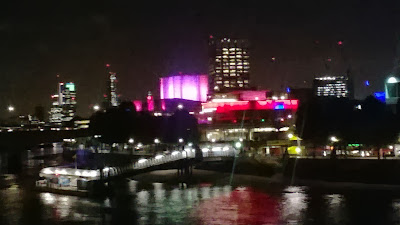 For the majority of my degree I have been a
For the majority of my degree I have been a
Marlowe’s plays are rarely performed, so whenever one of them pops up it’s an exciting opportunity to see how his hugely adaptable and
often ambiguous script has been interpreted. I’m clearly not the only one who
thinks this, because when I went to see Edward
II at the National Theatre a couple of weeks ago, the theatre was
completely packed. And it’s a big theatre! I’d never been to the National
Theatre before so it was a real treat. Its mixture of a modern foyer with
various exhibitions, restaurants and cafes, with the more traditional stage
areas makes it fun, inviting and exciting whilst retaining the much loved old-fashioned
feel of a trip to the theatre. Oh, and it goes pink at night – amazing!
In a nutshell, Edward
II is a tragedy/history play based on the King Edward II who faces mutiny
from his advisors and eventual torture and death for retrieving his lover
Gaveston from exile and running riot in the kingdom, neglecting both his
duties, and his wife and son. The play enjoyed a revival in the early 90s, when
there was a lot of discourse and debate surrounding homosexuality and AIDS.
Edward and Gaveston are often seen as homosexual martyrs, especially in Derek
Jarman’s haunting and graphic film adaptation of 1991.
This production has received very mixed reviews, most are
negative. In a particularly damning review from The Telegraph, one of the main
points of contention is the comedy of the production, and I am inclined to
agree. The entire performance was extremely farcical, Edward reminded me of
King Richard in the Disney version of Robin
Hood – a childish king who sucks his thumb and takes advice from a snake. Need
I say more?
The majority of the first half consisted of him and Gaveston
running around the stage shrieking with laughter and causing havoc. Meanwhile,
the down-trodden neglected Queen Isabella struts around sulkily, champagne and
cigarette in hand, berating her poor lot in life whilst her child runs at her
heels filling up her glass at any opportunity. This comical vibe is all well
and good if you’re just out for a fun evening at the theatre – but to make such
extreme comedy out of what was originally a profound, tragic and controversial work
seems rather too bold and brash.
Having said this, the second half is completely
contrastingly dark and sombre. We are suddenly confronted with the extreme
Marlovian brutality that was expected, but its clash with such a comic,
slapstick first part undermines it – whether there is a point trying to be made
here, I failed to understand, no matter which way I looked at it.
The mish-mash of Renaissance and modern costumes seemed
completely random – whilst Edward was in traditional King’s clothes, Gaveston
was in a leather jacket and jeans, and Edward’s brother-turned-sister was in a
feminine trouser suit. Indeed, the sex change of Edward’s brother
Kent as well as one of the advisors, Pembroke, to women, didn’t seem to have
much lasting impact. The presence of two screens on either side of the stage
which depicted various scenes was a point of interest, but again, where was it
going? In short, I felt as though I was being confronted with as many experimental
theatrical devices as possible, all on the cusp of making an interesting point,
but none quite reaching one, rendering them pretty much obsolete.
 Despite what may seem a wholly negative review, I did
actually enjoy the performance! As a reviewer and a literature student I
undeniably found a lot of the devices hard to get past, but once I let go of
expectations I was able to enjoy the play just as a dramatic exhibit of love
and suffering. The use of Gaveston’s actor as Edward’s murderer who sodomises
him with a burning rod conveyed the homosexual take they were aiming at –
however the lack of physical engagement between Gaveston and Edward throughout
the play illustrated a prudishness at actually carrying this out, which was
again frustrating.
Despite what may seem a wholly negative review, I did
actually enjoy the performance! As a reviewer and a literature student I
undeniably found a lot of the devices hard to get past, but once I let go of
expectations I was able to enjoy the play just as a dramatic exhibit of love
and suffering. The use of Gaveston’s actor as Edward’s murderer who sodomises
him with a burning rod conveyed the homosexual take they were aiming at –
however the lack of physical engagement between Gaveston and Edward throughout
the play illustrated a prudishness at actually carrying this out, which was
again frustrating.
I was certainly moved at the end by Edward’s son’s (now the
King) final speech: standing centre-stage, he calls out commands and orders to
an empty stage. The pessimism and anxieties regarding power, control, and the
monarchy that is so Marlovian are certainly highlighted here – if the only
influence that is taken from Marlowe himself.


No comments:
Post a Comment